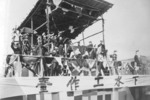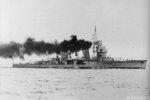Pinghai
| Country | China |
| Ship Class | Ninghai-class Light Cruiser |
| Builder | Jiangnan Arsenal |
| Laid Down | 28 Jun 1931 |
| Launched | 28 Sep 1935 |
| Commissioned | 18 Jun 1936 |
| Sunk | 25 Nov 1944 |
| Displacement | 2,383 tons standard |
| Length | 360 feet |
| Beam | 39 feet |
| Draft | 13 feet |
| Machinery | Four coal boilers, one oil boiler, two shafts |
| Power Output | 7,488 shaft horsepower |
| Speed | 21 knots |
| Range | 5,000nm at 12 knots |
| Crew | 340 |
| Armament | 3x2x140mm Krupp guns, 3x76.2mm Bofors anti-aircraft guns, 8x20mm guns, 2x2x535mm torpedo tubes, 8 torpedoes, depth charge throwers, 9 naval mines |
| Armor | None |
| Aircraft | 2 |
Contributor: C. Peter Chen
ww2dbaseAlthough the construction of the lead ship of the Ninghai-class light cruisers was outsourced to Japan, the second ship, Pinghai, was laid down by the Jiangnan Shipyard in Shanghai, China four months after the keel-laying of Ninghai after Jiangnan had received the proper modernization for such work; the parts and the chief engineer were brought in from Japan, however. The planned cost for the light cruiser 4,588,000 Yuan. The launching date was originally planned to coincide with the 10 Oct National Day celebration of 1933, but the Sino-Japanese tension of 1931 delayed the delivery of necessary material for the final phase of the construction. After the 1935 launch, she sat idle for some time before she was sent to Aioi, Japan for the fitting of weapons; although she was originally planned to receive the same Japanese-built weaponry, Japan refused to sell China heavy weapons; the Chinese turned to European firms Krupp and Bofors to purchase replacements. In Apr 1937, Pinghai was placed under the command of Captain Gao Xianshen and was assigned to the 1st Fleet as the flagship. After the Second Sino-Japanese War began in 1937, she participated in the Battle of Jiangyin, attempting to block the mouth of the Yangtze River from Japanese warships; during this battle, she was attacked by Japanese aircraft repeatedly, finally sunk in shallow water by carrier aircraft from Kaga on 23 Sep 1937. In 1938, she was raised and towed to Sasebo, Japan for repairs. In 1944, she was modernized and pressed into service under the new name Yasoshima as a convoy escort ship, serving in that role in the summer of 1944. Between Sep and Nov 1944, she was converted into a light cruiser. In late Nov 1944, she was sunk by carrier aircraft of the US Third Fleet west of Luzon, Philippine Islands.
ww2dbaseSources:
Baidu Baike
US Navy Naval Historical Center
Last Major Revision: Jan 2005
Light Cruiser Pinghai Interactive Map
Photographs
 |  |  |  |
Pinghai Operational Timeline
| 28 Jun 1931 | The keel of light cruiser Pinghai was laid down at the Jiangnan Arsenal in Shanghai, China with Chinese Secretary of the Navy Chen Shaokuan in attendence. |
| 28 Sep 1935 | Light cruiser Pinghai was launched at the Jiangnan Arsenal in Shanghai, China. |
| 18 Jun 1936 | Pinghai completed the fitting of weapons at Aioi, Japan. |
| 10 Jun 1944 | Former Chinese light cruiser Pinghai was renamed Yasoshima. |
| 25 Sep 1944 | Yasoshima received orders to move to the front. |
| 25 Nov 1944 | Yasoshima was sunk by American carrier aircraft west of Luzon, Philippine Islands. |
Did you enjoy this article or find this article helpful? If so, please consider supporting us on Patreon. Even $1 per month will go a long way! Thank you. Share this article with your friends: Stay updated with WW2DB: |
Visitor Submitted Comments
All visitor submitted comments are opinions of those making the submissions and do not reflect views of WW2DB.
» Second Battle of Shanghai
- » 1,150 biographies
- » 337 events
- » 43,917 timeline entries
- » 1,241 ships
- » 350 aircraft models
- » 207 vehicle models
- » 374 weapon models
- » 123 historical documents
- » 260 facilities
- » 470 book reviews
- » 28,543 photos
- » 432 maps
Winston Churchill
Please consider supporting us on Patreon. Even $1 a month will go a long way. Thank you!
Or, please support us by purchasing some WW2DB merchandise at TeeSpring, Thank you!
10 Feb 2009 06:40:15 PM
Yasoshima was sunk by bombs and torpedoes from Air Group 80 flying off USS Ticonderoga.